☆ 015 ; my favorite cathedral

Back in 2006 I was fortunate enough to be able to travel through the Netherlands, Belgium, and France. I was a second year then... I think. It's been awhile. In any case, I visited a lot of cathedrals, and I thought I would share my favorite since the Gothic section is so condensed. I'm not sure if Patrick showed it in class as I had to miss a day recently, but more photos can't hurt.
I really loved Ste. Chapelle in Paris, it's such a gem. It's located near the famous Notre Dame on the Ile de la Cité in the middle of the Seine. It was the king's personal cathedral, and the architects/craftsmen pulled out all the stops on this one, it's absolutely gorgeous! It doesn't have a crossing/transcept like the bigger cathedrals as this one is actually smaller in scale than most, but the nave design really opens up the interior. It felt like standing in a stained glass bubble; most of the walls were made of the glass windows, not much actual structure (that you can see on the inside, anyway). The actual structure is decorated lavishly, as well, instead of being left bare. For example, the webbing between the vaults of the ceiling structure are painted blue and patterned with the fleur-de-lis symbol. If you think back to the Pantheon where the ceiling represented a view of the universe and bring that idea forward to this particular cathedral, you can speculate that the king (who had absolute power in France during that time period) is the highest power, up there with God, since his symbol is all over the "sky" of the cathedral.
What intrigues me about Paris as a central point for France and Ste. Chapelle as a central point in the king's collection of buildings is this idea of singularity and the significance of being the center. Think about it in a geographic way: in a course I took last semester we learned about primate cities. A primate city is the largest city in a country, disproportionately larger, and is typically the center for all political and economic activity. Some examples include Mexico City, which has some 20 million people. The next largest city in Mexico has about 3 million, I think. The same goes for Bangkok, Thailand, Jakarta, Indonesia, Lagos, Nigeria and Tehran, Iran. These typically exist in third world nations where economic activities in these centers cause rural people to move into the city looking for jobs. This influx has disastrous consequences, like the development of slums. But primate cities do exist in first world countries, it's just more rare, one of which being Paris. France is all about Paris. This dynamic within the country occurred as the kings focused their power in Paris alone. Aristocrats had to move into Paris as that's where the court was held always, so economic and cultural activity followed. I think this idea translates into the architecture of the kings, especially Ste. Chapelle where you have a focus on the king. Structurally, as you can see in interior and exterior shots, there's a focus on the pulpit. I also think this is supported by the fact that the tripartite system of the bay elevations is cut off, a floor division separating the arcade from the upper levels of triforium and the clerestory. Commoners would worship below the king in the arcade area, while the king got all the splendors of the beautiful windows on the upper level.
Also, note the aedicules! NOTE THE AEDICULES! Now that that term has been reintroduced into my vocabulary I can't help but find them everywhere. Thanks, Patrick.
Below are some pictures. I tried to organize them in some sort of sequence, exterior to interior, areas that have proximity to each other.

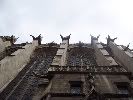





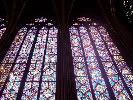
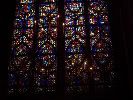
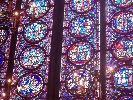
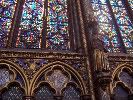

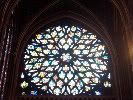



0 Comments:
Post a Comment
Subscribe to Post Comments [Atom]
<< Home